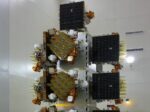Key Takeaways
Loft Orbital Federal (Loft Federal) won a NASA Flight Opportunities task order to integrate, launch, and operate an on-orbit demo of a fault-tolerant RISC-V flight computer with coprocessor support (aka “RadPC”).
The task order is issued under NASA’s 5-year Flight Opportunities IDIQ (ceiling $45M), which buys commercial flight and payload-integration services to mature technologies faster.
RadPC traces back to >10 years of NASA-funded research at Montana State University and commercialization by Resilient Computing; recent flights include the 2025 Blue Ghost lunar mission.
The demo focuses on radiation-tolerant, self-healing RISC-V computing on FPGAs with plug-in coprocessors—an approach complementary to NASA’s higher-end HPSC RISC-V roadmap.
What NASA Ordered—and Why It Matters
NASA has tasked Loft Federal to deliver end-to-end mission support (payload accommodation, licensing, satellite integration, launch campaign, and on-orbit ops) for a hosted-orbital demonstration of a fault-tolerant RISC-V flight computer. The work is placed on NASA’s fourth Flight Opportunities IDIQ vehicle, designed to accelerate flight testing via commercial providers. For dual-use and defense stakeholders, it’s another data point that space-grade edge computing is shifting toward open, modular RISC-V platforms.
Inside “RadPC”: Architecture and Flight Heritage
RadPC is a fault-tolerant computer built around RISC-V soft cores on radiation-tolerant FPGA fabric. The architecture uses redundancy and a voter to detect anomalies, isolate faults, and recover configuration—allowing the system to “self-heal” after single-event upsets. NASA TechPort notes ongoing efforts to automate software-implemented fault tolerance (SIFT) for a RISC-V system and to add dynamically reconfigurable coprocessors within the RadPC framework.
Resilient Computing’s product brief documents multi-venue flight heritage (balloons, sounding rockets, ISS and smallsats) and the lunar surface demo through CLPS. In February–March 2025, NASA reported RadPC traversed the Van Allen belts en route to the Moon on Firefly’s Blue Ghost mission; Montana State University later confirmed the payload’s lunar landing.
Loft Federal’s Role and Platform Fit
Loft Federal—the U.S. government subsidiary of Loft Orbital—specializes in secure turnkey missions that host third-party payloads on standardized satellite platforms with modular interfaces (“Hub”) and streamlined operations (“Cockpit”). The company’s model (dedicated or rideshare) is aligned with the Flight Opportunities hosted-orbital concept to cut time-to-flight and reduce program risk. For NASA’s RadPC demo, Loft Federal provides the managed pathway to space and sustained on-orbit ops.
How This Fits the Space-Grade RISC-V Landscape
RadPC sits in a broader pivot toward RISC-V for space systems:
NASA HPSC (High-Performance Spaceflight Computing): A separate, high-end 64-bit RISC-V multicore line (SiFive X28x-class vectors, security enclave) led by Microchip/JPL for missions through 2040+. This targets orders-of-magnitude performance gains for autonomy and AI, complementing RadPC’s fault-tolerant FPGA approach.
European efforts (Frontgrade Gaisler NOEL-V): ESA-backed radiation-hard RISC-V cores (e.g., NOEL-V) advancing European space-grade options.
Net effect: NASA’s task order gives the RadPC line more orbital demonstrations while the ecosystem matures across performance tiers—from soft-core FT computers to hardened HPSC-class MPUs.
Technical Deep-Dive: Fault Tolerance, Coprocessors, and SIFT
RadPC’s resilience strategy blends architectural redundancy (multiple RISC-V soft cores in lockstep with majority voting) with background reconfiguration of the FPGA fabric when a fault is detected. NASA materials and independent coverage describe quad-processor voting, error isolation, and recovery consistent with self-healing behavior. The current NASA task order specifically targets coprocessor support—i.e., dynamically reconfigurable accelerators that can be swapped or recovered in flight, while SIFT automation reduces developer burden. This is a pragmatic path to mix reliability with mission-specific compute (e.g., vision or compression).
Programmatics: Flight Opportunities, Hosted Orbital, and Timelines
Flight Opportunities buys access to commercial platforms—suborbital, balloons, hosted-orbital—to retire risk before operational missions. Recent NASA materials highlight hosted-orbital as a way to increase flight cadence and leverage commercial best practices. Loft Federal’s task order lives exactly here: integrate RadPC on a hosted platform and operate it long enough to gather statistically meaningful fault-tolerance and performance data.
Implications for Defense & Dual-Use Missions
On-orbit AI/edge compute: Pairing FT RISC-V control with reconfigurable accelerators enables autonomous ISR preprocessing, compression, and resilient C2 links in contested space environments.
Supply-chain and openness: Open ISA lowers long-term vendor lock-in and fosters multi-source rad-tolerant options (US and EU).
Ops tempo: Hosted-orbital rides reduce demo cycles from years to months, which is attractive for rapidly evolving defense payloads and TTPs.
RadPC Fault-Tolerant RISC-V Flight Computer (Hosted-Orbital Demo)
NASA/Loft Federal on-orbit demo of an FPGA-based, self-healing RISC-V flight computer with coprocessor support, building on CLPS lunar flight heritage.
4.3 / 5
Pros
- Open ISA; proven FT concepts; reconfigurable accelerators; fast path to space via hosted-orbital
Cons
- Soft-core performance ceiling vs. hardened MPUs; integration complexity of dynamic partial reconfiguration; software/toolchain maturity for SIFT automation.









